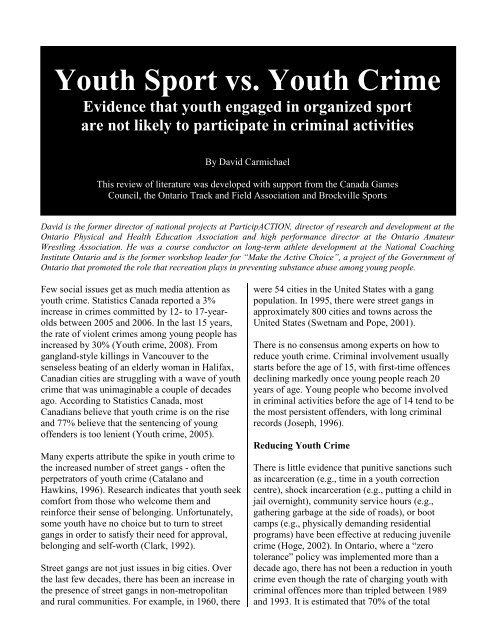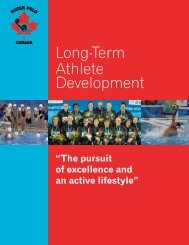Youth Sport vs. Youth Crime - Water Polo Canada
Youth Sport vs. Youth Crime - Water Polo Canada
Youth Sport vs. Youth Crime - Water Polo Canada
You also want an ePaper? Increase the reach of your titles
YUMPU automatically turns print PDFs into web optimized ePapers that Google loves.
<strong>Youth</strong> <strong>Sport</strong> <strong>vs</strong>. <strong>Youth</strong> <strong>Crime</strong>Evidence that youth engaged in organized sportare not likely to participate in criminal activitiesBy David CarmichaelThis review of literature was developed with support from the <strong>Canada</strong> GamesCouncil, the Ontario Track and Field Association and Brockville <strong>Sport</strong>sDavid is the former director of national projects at ParticipACTION, director of research and development at theOntario Physical and Health Education Association and high performance director at the Ontario AmateurWrestling Association. He was a course conductor on long-term athlete development at the National CoachingInstitute Ontario and is the former workshop leader for “Make the Active Choice”, a project of the Government ofOntario that promoted the role that recreation plays in preventing substance abuse among young people.Few social issues get as much media attention asyouth crime. Statistics <strong>Canada</strong> reported a 3%increase in crimes committed by 12- to 17-yearoldsbetween 2005 and 2006. In the last 15 years,the rate of violent crimes among young people hasincreased by 30% (<strong>Youth</strong> crime, 2008). Fromgangland-style killings in Vancouver to thesenseless beating of an elderly woman in Halifax,Canadian cities are struggling with a wave of youthcrime that was unimaginable a couple of decadesago. According to Statistics <strong>Canada</strong>, mostCanadians believe that youth crime is on the riseand 77% believe that the sentencing of youngoffenders is too lenient (<strong>Youth</strong> crime, 2005).Many experts attribute the spike in youth crime tothe increased number of street gangs - often theperpetrators of youth crime (Catalano andHawkins, 1996). Research indicates that youth seekcomfort from those who welcome them andreinforce their sense of belonging. Unfortunately,some youth have no choice but to turn to streetgangs in order to satisfy their need for approval,belonging and self-worth (Clark, 1992).Street gangs are not just issues in big cities. Overthe last few decades, there has been an increase inthe presence of street gangs in non-metropolitanand rural communities. For example, in 1960, therewere 54 cities in the United States with a gangpopulation. In 1995, there were street gangs inapproximately 800 cities and towns across theUnited States (Swetnam and Pope, 2001).There is no consensus among experts on how toreduce youth crime. Criminal involvement usuallystarts before the age of 15, with first-time offencesdeclining markedly once young people reach 20years of age. Young people who become involvedin criminal activities before the age of 14 tend to bethe most persistent offenders, with long criminalrecords (Joseph, 1996).Reducing <strong>Youth</strong> <strong>Crime</strong>There is little evidence that punitive sanctions suchas incarceration (e.g., time in a youth correctioncentre), shock incarceration (e.g., putting a child injail overnight), community service hours (e.g.,gathering garbage at the side of roads), or bootcamps (e.g., physically demanding residentialprograms) have been effective at reducing juvenilecrime (Hoge, 2002). In Ontario, where a “zerotolerance” policy was implemented more than adecade ago, there has not been a reduction in youthcrime even though the rate of charging youth withcriminal offences more than tripled between 1989and 1993. It is estimated that 70% of the total
money spent on youth crime in Ontario is spent onincarceration (Owen, 1993), which is estimated tocost $100,000 a year for each young offender (St.Thomas, 2008). The Honourable Hal Wootten,Queen’s Counsel, former Royal Commissioner intoAboriginal Deaths in Custody in Australia, urgeddelegates at a 1994 conference on preventing youthcrime to “ have the courage to stand up againstthose who believe that further dehumanization isthe cure for those who have lost their way insociety” (Osmand, 1994).According to many criminology experts, the mosteffective approach to reducing youth crime is tosteer young people away from negative socialactivities before they become involved in criminalactivities (Hartmann and Depro, 2006). This seemsto be supported by Canadians. Rehabilitation wasseen by 64% of the public as the most effectiveway of dealing with young offenders, notincarceration (Hartnegal and Baron, 1994). Thereneeds to be a balanced approach to dealing withyoung offenders. Some may need to beincarcerated, but many more need to be engaged incommunity programs that build character, increaseself-esteem and develop life skills (Millie et al,2005). Social development programs that provideyouth with positive peer interactions, opportunitiesto develop problem-solving skills and a supportiveadult help reduce the risk factors associated withyouth crime (Andrews et al, 1990).Social Development through Organized <strong>Sport</strong>Organized sport is being used throughout the worldto curb political extremism and to facilitate peace.In 2007, for example, the United Nationsestablished a “Global <strong>Sport</strong> Fund” with a $10million donation from the country of Qatar toengage youth from different parts of the world,particularly those in conflict regions, in sport.Sheikh Saud bin Abdulrahman al-Thani, Secretary-General of the Qatar Olympic Committee, statedthat “the <strong>Sport</strong> Fund targets young people at theage when the temptation to experiment with illegaldrugs is high. The main purpose is to promotesports activity among young people and to preventdrug use and crime worldwide” (UNODC, 2007).With more than 1.2 billion 15- to 24-year-olds inthe world, the United Nations realized that youthsport represents one of the most dynamicmechanisms in society for transforming dangerousand violent conflict situations because organizedsport can engage youth of all races, genders andclasses (United Nations, 2005).Daniel Tarschys, former Secretary General of theCouncil of Europe, stated in 1995 that“the hidden face of sport is also the tens ofthousands of enthusiasts who find, in theirfootball, rowing, athletics or rock climbingclubs, a place for meetings and exchange, but,above all, the training ground for communitylife. In this microcosm, people learn to takeresponsibility, to follow rules, to accept oneanother, to look for consensus, to take ondemocracy. Seen from this angle, sport is parexcellence, the ideal school for democracy”.Reducing <strong>Crime</strong> through Organized <strong>Sport</strong>It is unrealistic to claim that organized youth sportalone can reduce the levels of youth crime insociety. The causes of youth crime are complexand multidimensional. Organized sport programscan, however, contribute to reducing youth crimeby giving young people a positive identity, feelingsof empowerment and by helping youth acquireleadership, teamwork and self-governance skillsunder adult supervision (Jamieson and Ross, 2007).Several studies have demonstrated that youth sportdoes prevent youth crime (Utting, 1996). In KansasCity, Missouri, evening and midnight basketballprograms reduced the crime rate among AfricanAmerican youth (Hawkins, 1998). According to theKansas City Police, there was a one-third to twothirdsreduction in juvenile crime in areas wherethere was a midnight basketball program for 10- to21-year-olds (Kennedy and O’Brien, 1996). InAlexendria, Virginia, there was a reduction incrime among young women who participated in arunning program sponsored by the Road RunnersClub of America (Vibar-Bawzon, J., 1997). InAustralia, rehabilitation programs that engagedAboriginal young offenders in organized sportcontributed significantly to reducing crime
ates in Aboriginal communities (Mason andWilson, 1988).The organized sport programs that are successful atreducing youth crime appear to develop feelings ofcompetence, connectedness and empowermentamong youth (Gatz et al, 2002). <strong>Sport</strong> programsdominated by unequal access and the obsession towin-at-all-costs often foster social problems amongat-risk youth (Hawkins, 1998). Northern Fly-In<strong>Sport</strong>s Camps in Manitoba that focused on buildingteamwork, character and self-esteem amongAboriginal young offenders and potential youngoffenders resulted in an average 49% reduction inyouth crime in the 8 communities that offered theprogram (Winther and Currie, 1987). A multi-sportprogram in Bristol, England that engaged youth atriskof offending or reoffending resulted in a 43%reduction in juvenile crime between October 1997and January 1998 when compared to crimestatistics from 12 months earlier (<strong>Sport</strong> England,1999).The benefits of organized sport for at-risk youthare maximized if programs are skills-based, teamfocusedand learning-rich (Diana, 2000). Organizedsport programs that engage at-risk youth byempowering them and providing opportunities forpositive peer mentoring will foster reductions inyouth crime (Sheehan et al, 2002). Youngoffenders in organized sport programs havedemonstrated significant increases in ratings inperceived competence in sport skills and increasedself-esteem (King et al, 1998).Although there is limited empirical evidence of adirect causal relationship between youth sport andyouth crime reduction, there are several rationalesas to why youth sport reduces youth crime,including that organized sport (Nichols, 1997):Keeps young people busy and out of troubleMeets a need that youth have forexcitementMakes young people feel empoweredMeets a need that youth have for risk-takingIncreases feeling of connectednessDevelops problem-solving skillsFosters teamworkDevelops athletic abilitiesIncreases self-esteemDevelops cognitive competenciesProvides positive role-models and mentorsDevelops decision-making skillsMakes youth feel specialProvides employment opportunitiesOrganized sport can prevent youth crime bydeveloping capable, mature and responsible youth(Howell, 1995). But few governments in the worldhave established policies and committed resourcesthat support the provision of sport opportunities foryouth at risk of getting involved in criminalactivities - who are the individuals that wouldprobably gravitate most toward organized sport ifthey could choose sport teams over street gangs(Mastrich, 2002).Policies and Programs in the United KingdomPrior to the 1997 General Election in Britain, theLabour Party stated that “sport can be crucial to thesocial and personal development of young people.By participating in sporting activities they canlearn to differentiate between good and badbehaviour”. The Labour Party declared that if theywere elected they would “develop sportingopportunities for young people to help them fostera sense of their value to society and to help tackleproblems of youth crime” (Crabbe, 2000).After the Labour Party was elected in 1997, theBritish government started supporting sportprograms for at-risk youth. The organizingcommittee for the London 2012 Olympic Games iscurrently promoting the importance of sport for atriskyouth. Many great athletes from the UnitedKingdom have spoken publicly about how sportprobably helped keep them away from criminalactivities. Sebastian Coe, a Gold medalist in the1500 metres at the 1980 and 1984 Olympic Games,wants sport to be recognized as an effectivemechanism for empowering and educating youth totackle the problems they face and for building thesocial skills they need to succeed. London 2012 ispromoting the fundamental and lasting role of sportin changing the lives of young people throughoutthe world (Holmes, 2007).
There have been several successful programs inEngland to engage at-risk youth in sport. BristolCity Council, for example, has been using sport asa central policy mechanism in its efforts toovercome exclusion and to regenerate some of thepoorest areas of the city. Its efforts have resulted inlower youth crime rates (<strong>Sport</strong> England, 1999). InWest Yorkshire, a sport counselling scheme aimedat reducing re-offending rates encourages youngpeople on probation to make constructive use oftheir leisure time through sport. The researcherswere able to conclude that the project wassuccessful in helping to halt long-term recidivismamong young offenders, including some withlengthy histories of serious crimes. Those whoparticipated in 8- to 12-weeks of sports counsellingand programming experienced significantimprovements in their self-esteem and perceptionsof their own fitness (Nichols and Taylor, 1996).Need for Non-Traditional PartnershipsCommunity sport networks involving local sportgroups and non-traditional stakeholders such as thepolice, social service agencies and local businessesseem to be the most effective at reducing youthcrime (Jamieson and Wolter, 1998). The sportprograms in England that have been successful atreducing youth crime involve a variety of nontraditionalstakeholder groups including the localpolice, health authorities, municipal social servicedepartments, housing agencies, residentsassociations, and local businesses (<strong>Sport</strong> England,1999).Although many of the non-traditional partnershipsdocumented by <strong>Sport</strong> England have beenestablished at a community level, there areopportunities to create a <strong>Canada</strong> wide movementfor sport for at-risk youth in partnership with nontraditionalprovincial/territorial and nationalgroups. The Royal Canadian Mounted Police(RCMP), for example, has identified supportingyouth as one of its five strategic priorities alongwith fighting organized crime, battling terrorism,supporting Aboriginal communities, andsafeguarding <strong>Canada</strong>’s economic integrity. A keyobjective of the RCMP is crime prevention throughsocial development (RCMP, 2007).Investing in <strong>Sport</strong> for At-Risk <strong>Youth</strong>There is an immediate need for Canadians to investin sport for at-risk youth. While youth crime ratesare rising, the number of Canadian youthparticipating in sport is rapidly declining. Between1992 and 2005, for example, the sport participationrate among 11- to 14-year-old boys dropped from74% to 62% while participation rates among 11- to14-year-old girls dropped from 54% to 48% (Clark,2008). This trend could be reversed if even afraction of the government money spent onpunitive approaches to dealing with youth crime(e.g., incarceration) was directed at engaging allyouth in organized sport. An investment into sportfor at-risk youth would significantly reduceincarceration costs, minimize personal harm toyouth and adults, and maximize socialdevelopment among young people (Diana, 2000).Many coaches have compelling stories about youthwho have chosen sport over juvenile crime. Butanecdotal evidence is no longer enough. Federal,provincial/territorial and municipal governmentsneed empirical evidence to establish policies andcommit programming resources. Philanthropistsand corporate executives need empirical evidenceto be assured that major financial gifts to sportorganizations will contribute as much to the healthand well-being of Canadians as donations tohospitals, universities and health charities.According to the True <strong>Sport</strong> Foundation, more than90% of Canadians believe that sport can andshould make a positive contribution to the socialdevelopment of youth. But fewer than 20% believethat sport is living up to its potential (True <strong>Sport</strong>,2002).One way to demonstrate that sport in <strong>Canada</strong> isliving up to its potential is for sport organizationsto engage at-risk youth and to gather data, inpartnership with local police, which demonstratesthat youth who are engaged in organized sport arenot participating in criminal activities. To do this,methodologies need to be established thatmeasure both variables of engagement and crimereduction (Smith and Waddington, 2004).Participation barriers such as cost andtransportation need to be removed so programs are
accessible by all youth regardless of gender, socioeconomicstatus, ethnicity, cultural background orability, and sport programs need to focus onbuilding character and self-esteem (Gatz et al,2002).Organized sport programs for youth that developsocial skills, mentoring opportunities with adultrole models, cognitive skills, and increase feelingsof self-confidence and self-esteem provide anantidote to antisocial behaviour (Saskatchewan,2003). With Vancouver 2010 on the horizon, therecould not be a better time for <strong>Canada</strong> to show theworld that organized youth sport does, indeed,reduce youth crime.ReferencesAndrews, D.A., Bonat, J. and Hoge, R.D. (1990).Classification for effective rehabilitation:Rediscovering psychology. Criminal Justice andBehavior. Vol. 17.Catalano, R.F. and Hawkins, J.D. (1996). The socialdevelopment model: A theory of antisocial behaviour.In J.D. Hawkins (Ed.), Delinquency and crime: Currenttheories. Cambridge, UK: Cambridge University PressClark, Cynthia M. (1992). Deviant adolescentsubcultures: Assessment strategies and clinicalinterventions. Adolescence. Summer.Clark, Warren (2008). Kids sports. In Component ofStatistics <strong>Canada</strong> Catalogue number 11-008-X.Canadian Social Trends. Statistics <strong>Canada</strong>. Pgs 54-61.Crabbe, Tim (2000). A sporting chance? Using sport totackle drug use and crime. Drugs, Education andPolicy. Vol. 7. No. 4.Diana, A. (2000). <strong>Youth</strong> at play: Preventing youthproblem behavior through sport and recreation.Microform Publications. University of Oregon. Eugene.Gatz, M., Messner, M.A. and Ball-Rokeach, S.J. (2002).Paradoxes of youth and sport. SUNY series on sport,culture and social relations. State University of NewYork Press.Hartmann, Douglas and Depro, Brooks (2006).Rethinking sports-based community crime prevention: Apreliminary analysis of the relationship betweenmidnight basketball and urban crime rates. Journal of<strong>Sport</strong> and Social Issues. May. Vol. 30. No. 2.Hartnegal, T. and Baron, S. (1994). It’s time to getserious: Public attitudes toward justice in <strong>Canada</strong>.Research discussion paper. University of Alberta.Population Research Laboratory. Edmonton.Hawkins, B. (1998). Evening basketball leagues: Theuse of sport to reduce African American youth criminalactivity. International <strong>Sport</strong>s Journal. Summer. Vol. 2.No. 2.Hoge, Robert D. Position paper: Responses to youthcrime. Carleton University.Holmes, Dame Kelly (2007). <strong>Sport</strong> has the power tochange lives. Daily Telegraph. September 26.Howell, J.C. (1995). Guide for implementing thecomprehensive strategy for serious, violent and chronicjuvenile offenders. Washington, D.C: Department ofJustice, Office of Juvenile Justice and DelinquencyPrevention.Jamieson, Lynn M. and Ross, Craig, M. (2007).Research update: Using recreation to curb extremism.Parks and Recreation. February. Vol. 42. No. 2.Jamieson, L.M. and Wolter, S.A. (1998). <strong>Sport</strong> in thecity. Conference proceedings. July 2-4. SheffieldHallam University, U.K. Leisure Industries ResearchCentre. Pgs. 280-294.Joseph Rowntree Foundation (1996). Understandingand preventing youth crime. Social policy researchpaper. North Yorkshire, U.K.Kennedy, Kostya and O’Brien, Richard (1996). Roundmidnight. <strong>Sport</strong>s Illustrated. August. Vol. 85. No. 8.King, T.C., Valerius, L. and Collins, J.R. (1998).Ground Zero: A collaborative substance abuseprevention and intervention program for at-riskadolescent. Journal of Parks and RecreationAdministration. Fall. Vol. 16 No. 3.Mastrich, J. (2002). Really winning: Using sports todevelop character and integrity in our boys. St.Martin’s Press. New York.
Mason, G. and Wilson, P. (1988). <strong>Sport</strong>, recreation andjuvenile crime: An assessment of the impact of sportand recreation upon Aboriginal and non-Aboriginalyouth offenders. Australian Institute of Criminology,Canberra.Millie, A., Jacobson, J., McDonald, E. and Hough, M.(2005). Anti-social behaviour strategies: Finding abalance. Paper from the Joseph Rowntree Foundation.The Policy Press. Britain.Nichols, G. and Taylor, P. (1996). West Yorkshiresports counselling: Final evaluation. West Yorkshire<strong>Sport</strong>s Counselling Association. West Yorkshire,England. March.Nichols, G (1997). A consideration of why activeparticipation in sport and leisure might reduce criminalbehaviour. <strong>Sport</strong>, Education and Society. Vol. 2. No. 2.Osmand, Meredith (1994). Preventing youth crime: Thechallenge beyond diversion. Presented at Conference on<strong>Youth</strong> <strong>Crime</strong> in Terrigal, New South Wales, Australia.Joint initiative of the Juvenile Justice Advisory Councilof New South Wales and the Australian Institute ofCriminology. April 13-15.Owen, P. (1993). The downside of zero tolerance:Ontario locks up more kids than any other province; itdoesn’t seem to be helping. Toronto Star. December 5.RCMP (2007). Strategic priority: youth. RoyalCanadian Mounted Police. July 30.Swetnam, Josh and Pope, Jacqueline (2001). Gangs andgang activity in a non-metropolitan community: Theperception of students, teachers, and police officers.Social Behaviour and Personality. Vol. 29. No. 2.Saskatchewan (2003). The impact of culture/arts, sportand recreation on anti-social behaviour in youth:Evidence and analysis. Research paper. Strategic Policyand <strong>Youth</strong> Branch. Ministry of Culture, <strong>Youth</strong> andRecreation. Province of Saskatchewan. August.Sheehan, K., DiCara, J.A., LeBailly, S., and Christoffel,K.K. (2002). Adapting the gang model: Peer mentoringfor violence prevention. Art of Health Promotion.July/August. Vol. 6. No. 4.Smith, Andy and Waddington, Ivan (2004). Using sportin the community schemes to tackle crime and drug useamong young people: Some policy issues and problems.European Physical Education Review. October. Vol 10.No. 3.<strong>Sport</strong> England (1999). The value of sport. Published by<strong>Sport</strong> England. June.St. Thomas University (2008). Myths about youth crimein <strong>Canada</strong>: Fact sheet. Centre for Research on <strong>Youth</strong>At risk. New Brunswick.True <strong>Sport</strong> (2002). Canadian Public Opinion Survey on<strong>Youth</strong> and <strong>Sport</strong>. Posted at truesport.ca.United Nations (2005). Enhancing youth participationand action in the implementation of CopenhagenDeclaration of the World Summit for SocialDevelopment. Economic and Social CouncilCommission on Social Development. United Nations.New York. February session.UNODC (2007). Press conference on Global <strong>Sport</strong>Fund of United Nations Office on Drugs and <strong>Crime</strong>.United Nations. Department of Public Information.News and Media Division. New York. December 12.Utting, D. (1996). Reducing criminality among youngpeople: A sample of relevant programmes in the UnitedKingdom. Home Office research study. London,England.Vibar-Bawzon, J. (1997). Developing sports as a socialdeterrence to social deviance: The role of sport onwomen and girl’s lives. Presentation at the SecondScientific International Conference for Women<strong>Sport</strong>. October 21-24. Alexandria University, Egypt.Winther, N. and Currie, P. (1987). Northern Fly-In<strong>Sport</strong>s Camps: A joint sport development/crimeprevention project. Presentation at the North AmericanSociety for the Sociology of <strong>Sport</strong> Conference.Edmonton, Alberta. November 5.<strong>Youth</strong> crime (2005). The state. Statistics <strong>Canada</strong>.January 8.<strong>Youth</strong> crime (2008). The daily. Statistics <strong>Canada</strong>. May16._____________________________________________Copyright © 2008 by Active Healthy Links Inc.Active Healthy Links Inc., P.O. Box 334,Brockville, Ontario K6V 5V5 (613) 345-1112Toll free 1-877-345-0822 activehealthylinks.com
















